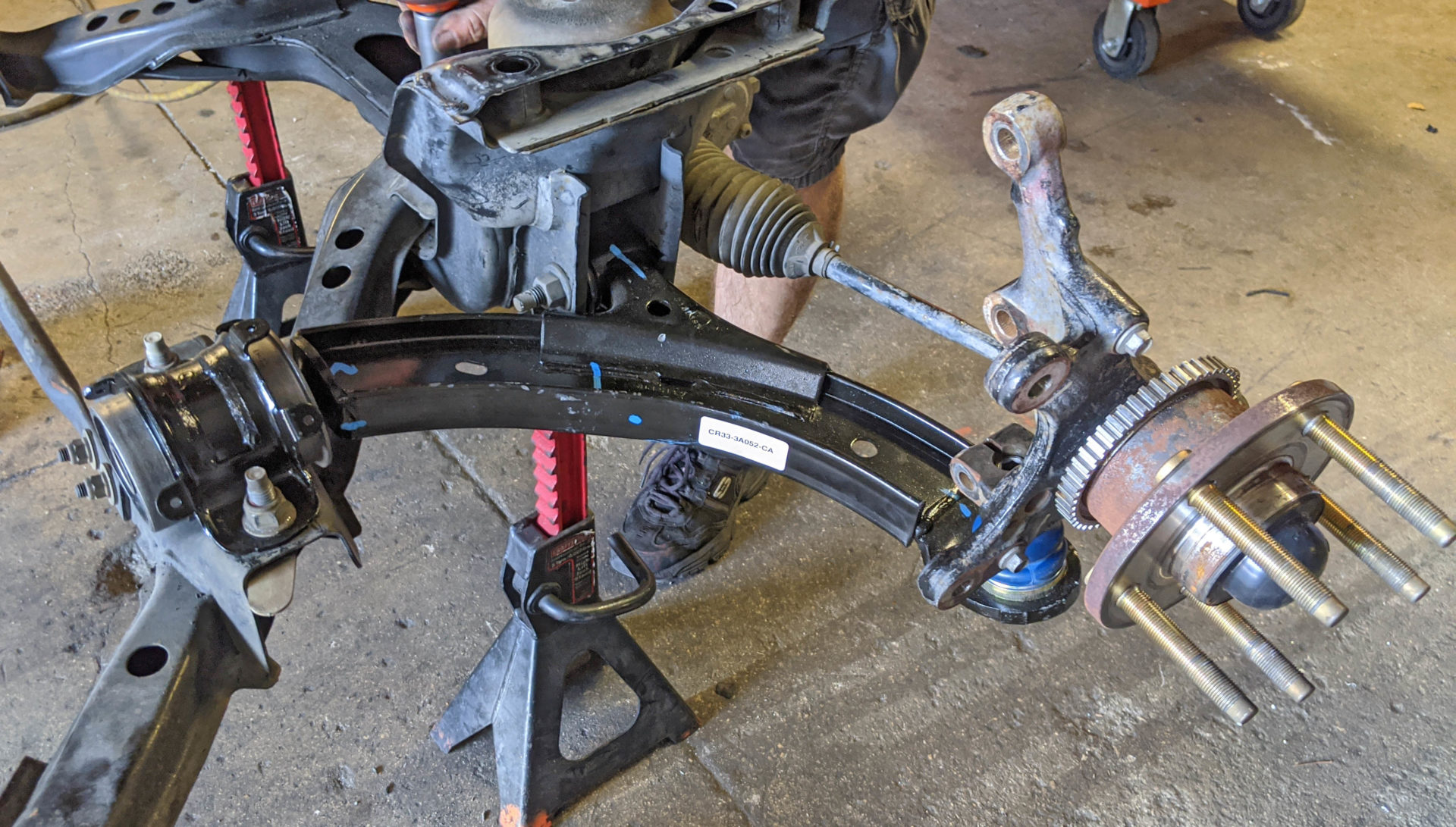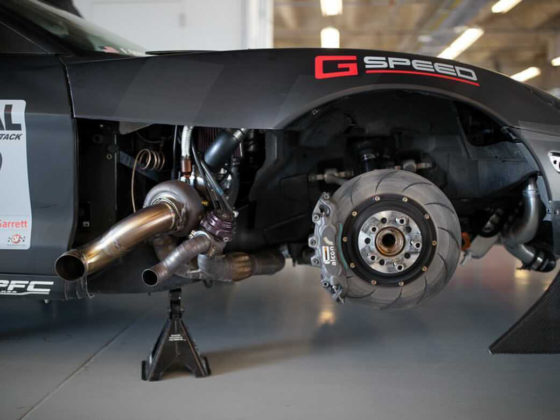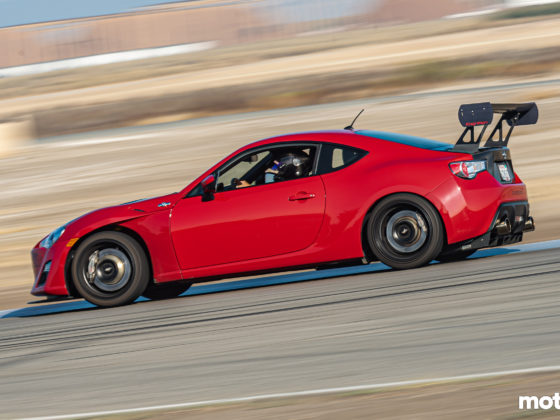 We bolted the front subframe back into the car and was ready to attack the rear of the car.
We bolted the front subframe back into the car and was ready to attack the rear of the car.
 The rear axle has these weights mounted just above the rear control arm. When changing the spring rates, ride height and geometry of the suspension, the ‘tuning’ of these weights becomes irrelevant and removing them to reduce unsprung weight is the best solution.
The rear axle has these weights mounted just above the rear control arm. When changing the spring rates, ride height and geometry of the suspension, the ‘tuning’ of these weights becomes irrelevant and removing them to reduce unsprung weight is the best solution.
 These things are often frozen on and aren’t loosened with an impact gun.
These things are often frozen on and aren’t loosened with an impact gun.
 NanoPro MT Penetrating Lubricant is some incredible stuff. I’ve won a lot of races using their products and their penetrating oil is by far the best that I’ve ever used. It quickly frees up frozen bolts.
NanoPro MT Penetrating Lubricant is some incredible stuff. I’ve won a lot of races using their products and their penetrating oil is by far the best that I’ve ever used. It quickly frees up frozen bolts.
 Removing these weights will help the response and handling of our Mustang on track.
Removing these weights will help the response and handling of our Mustang on track.
 Next we had to remove the stamped steel rear lower control arms.
Next we had to remove the stamped steel rear lower control arms.
Quick Reference:
Page 1 – Panhard Bar vs Watts Link Pros & Cons
Page 2 – Analysis: Panhard Bar Geometry vs Watts Link
Page 3 – Overview & Front S197 Geometry vs Extended Ball Joint LCA
Page 4 – Front LCA Removal
Page 5 – Front LCA Install
Page 6 – Rear Axle Weight Removal
Page 7 – Rear Lower Control Arm & Panhard Bar Install




16 comments
I’ve always felt polyurethane or delrin bushings in live axle control arms to be a counterintuitive choice. With the non-compliant bushing the control arms turn into torsion springs when one side articulates. Or on the other hand – great way to save weight on an anti-roll bar.
Secondly, won’t the front tie rod end also need relocating when moving the outer ball joint? On an E36, moving the ball joint 10mm introduces basically an equal amount of bumpsteer.
It depends on the durometer of the polyurethane and the articulation of the arms. Poly bushings in the 4-link 79-04 chassis is quite terrible in terms of ride quality, roll resistance and grip; but for the S197 a softer durometer polyurethane isn’t that bad due to the S197’s rear geometry and lack of articulation. Now using Delrin isn’t the best idea.
Good eye regarding the bumpsteer when using extended balljoint front lower control arms. We are going to discuss that and the importance of a bumpsteer kit when using extended ball joints in the next article.
@twist, “With the non-compliant bushing the control arms turn into torsion springs when one side articulates.” That would be true for an unequal four-link suspension, such as the 79-04 Mustang. The four link binds a lot because the four links over-constrain the axle. The 2005-14 Mustang uses a three-link rear, with a Panhard, which is not over-constrained. There is no bind, even with spherical bearings in all the suspension joints. In fact, that’s what I have. One of the reasons the S197 is leaps and bounds ahead of the previous generation.
Yes, Delrin wouldn’t make sense as it wouldn’t be able allow the links to “twist” during articulation.
I know there’s probably a good reason Ford put those weights there, but something seems hilarious about it. “Hm, yes, let’s add unsprung weight to the live axle, this is an excellent idea.”
The PHB vs Watts thing reminds me of stuff that comes up on discussions on how to fix the 1st gen RX-7, with a similar result, albeit it’s switching to the PHB instead of sticking with it. Unless you have a lot more design freedom in where stuff goes (ala Trans Am tube chassis stuff or so on) it just seems like weight trumps any benefit from more complex axle location.
I have seen weights like that on other cars. I am pretty sure that they act as ‘tuned mass dampers’ to reduce resonance at certain speeds (most likely highway speed.)
I really don’t understand why the owner opted out of stiffer bushings in the front and yet went ahead with PU on the rear.
The front bushings see much higher loads and this has a huge effect on braking stability. From my experience the change in NVH is barely noticeable because the bushings only see high loads under acceleration and braking. The greatest change in NVH happens when you swap out vertical load carrying bushings.
Also, not sure why the entire control arm needs to be replaced if all you are doing is swapping ball joints and bushings.
And, yes, as the first commenter mentioned bumpsteer will be increased unless the front tie-rods are offset.
The owner could simply have installed dampers with adjustable rebound if roll control was the primary goal. I am pretty sure that it would have been cheaper than dropping the entire front subframe, and swapping control arms, along with the necessary subsequent alignment.
“…but since our car is a dual purpose street/track car, we didn’t want the increased Noise Vibration & Harshness (NVH) of a stiff bushing and decided to use a new large diameter OEM style bushing because they hold up quite well and don’t affect the geometry much when new.”
The Steeda LCA with Extended Ball Joints cost $299 and include new bushings. The Extended Ball Joint costs $121 by itself and new bushings range from $145-184, and can cost up to $499 for the Ford Performance LCA Bushing Kit. The cheapest option to replace the bushings and ball joints on our existing arms would be $266; so we could have saved $33 if we wanted to spend more in the long run for time and labor to push out the bushings and ball joints and install the new ones. If you’re doing this at home and want to do all the work yourself, and value your time to do this job at less than $33, then it may make sense. For our project, saving money is a high priority and the Steeda LCA option is the least expensive and easiest solution.
Well, I will say that this is a surprise. There are some reasons why modifying a domestic vehicle is better, and this is one of them.
Just to excuse my concern, new control arms on a Mercedes run upward of $1000.
Shock damping to counter geometry issues is kind of gross; strut suspensions do really awful things when the control arm orientation gets to certain ranges that are going to hurt predictability.
I’m curious as to why you dropped the K-member/subframe to replace the front control arms. I replaced the control arms on my 08 GT without needing to do that, but I’m not sure if the later S197’s are a bit different in that regard (or if it was to make documenting the removal/install easier).
I definitely think replacing the arms in lieu of just the ball joints are the way to go. I’ve done both and replacing the entire arm assembly was much easier as well as faster. Considering the price difference (depending on parts, etc), I wish I had done that the first time.
I’ve been enjoying these articles. Hopefully more people can see how much fun these cars can be on track.
I noticed that you didnt use relocation brackets for the lower control arms. Do you feel these are unnecessary?
Also neither the UCA nor the LCAs are adjustable. Is the pinion angle not that important to get right?
It’s just another adjustment tool to change the handling and effects of the car’s suspension. For a budget build, and based off of our level of lowering, it was not worth it or needed to raise the instant center with the lower control arm relocation brackets. They can be a useful adjustment tool, but not necessary for what we are trying to do. The money is better spent elsewhere.
Is there a benefit in using a poly bushing on the rear to add traction, getting out the harsh response after bumps. With this you add a spring motion in the axle rotation.
I mooved for the panhard on my project cos of the low RC, but its hard to calculate for the jacking effect when the bar is not paralele to the gound and you have a soft suspension with 8″ travel.
Becouse of this im thinkin in making a dual suport so the linkage can be changed depending on the track is clockwise or counter clock.
It depends on your application and what the problem is. In the application of an S197 Mustang, polyurethane can reduce traction when used in the 3rd link.
NASCAR has adjustable mounts on both sides of the panhard bar so they have a lot of adjustability of the RC and jacking effect to make the car do what they need it to. With 8″ of travel, it sounds like you have an off-road application.
I believe steeda makes a PHB that is adjustable in height..at BOTH ends. That way, the PHB can be made
to be not only lower to the ground, but also…..almost parallel to the ground. I think it has several bolt hole positions on both drivers side…and also pass side. Ok, just checked, it’s no longer available for the 05-14 cars.
IMO, if the car is lowered, and LCA relocate brackets are not used, the LCA’s will be higher at axle end..and handling is terrible, the back end is all over the map, and extremely dangerous in the wet. You will also get terrible wheel hop. I’m only lowered 1.25″ at the rear. I installed BMR LCA relocate brackets…which are a better design and much stronger than the steeda version. The steeda version has to be welded in. On the BMR version, the axle weights are tossed, and 3 holes are used to bolt each relocate bracket into place. The BMR version allows for 3 x positions of the LCA..with a 2-3-4″ drop at axle end. I started with the 2″ drop, then moved to the 3″ drop a year later. You want the LCA’s to be at least level to the ground…and preferably a bit lower at axle end. Go too low and you will get brake hop… hence the 4″ drop option is seldom used.
The rules in Grand-Am required the stock suspension geometry, so I was beating 997 Porsches and E46 & E92 M3s with the LCA higher on the axle side. I wouldn’t say it’s as dramatic as youre putting it. It can easily be made to work, and this project turned out pretty well on track. Which will be discussed in an upcoming article. Stay tuned!
I recently purchased a 2014 mustang pony with v6 with 12000miles. I have started to autocross with it and want to upgrade handling. I replaced p zero tires bf goodrich AS2 tires.
I thought i would start at the rear end of car and work my way to the front. I want to replace rear sway bar with steeda 7/8. Replace rear springs and shocks with steeda and drop 1.5 inchs. Followed with a steeda pan hard bar.
Is this best way to move forward or will other upgrades make a more significant improvement?
Thanks